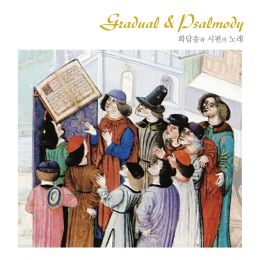화답송은 가톨릭교회의 미사에서 첫 번째 독서 후에 부르는 전례성가로서 말씀 전례의 본질적 부분을 차지하는 매우 중요한 노래이다. 이 노래는 가사가 주로 시편Psalm으로 이루어져 있기 때문에 ‘화답시편’Responsorial Pslam이라고도 불리며, 일반적으로 “후렴+시구+후렴(반복)”으로 구성되는 답창 형식의 음악적 구조를 갖는다.
그레고리오 성가에서 화답송은 다른 노래들에 비해 음악적으로 보다 세련되며 복잡한 형태를 띠고 있는데, 12세기경에는 파리의 노트르담 성당을 중심으로 다성음악Polyphony 양식으로 이루어진 화답송이 실제 전례에서 사용되기 시작하면서 서양 음악의 발전사에 큰 영향을 미치게 된다. 하지만 음악적 양식의 발전과는 정반대로, 이 노래가 하느님 말씀에 대한 공동체의 화답 노래라는 본래의 의미가 크게 위축되어 전례적 기능을 제대로 수행하지 못한 채 마치 선창자나 성가대만이 부르는 노래로 오랫동안 잘못 이해되기도 하였다. 제2차 바티칸공의회는 이러한 문제를 해결하고 교회의 오랜 전통에 따라 이 노래를 복원시키기 위해 특별히 회중이 가능한 적극적으로 이 노래에 한 몫을 차지해야 한다는 점을 강조하고 있다. 이러한 공의회의 요구에 따라 모국어로 된 화답송 노래들이 다양한 형태로 작곡되고 있으며 이 음반 속에 담긴 노래들 안에는 이러한 공의회의 정신이 충만하게 반영되어 있다.
이 음반의 화답송 안에서 시편 본문 부분(시구)은 신자들과 함께 부르는 후렴과 음악적 대비를 이루면서도 조화롭게 연결돼있다. 또한 시구 노래는 전통적 교회 선법에 의한 시편창에서처럼, 열 가지 기본 양식으로 고정시켰기 때문에, 시구를 노래하는 사람이 가사에 집중하며 익숙한 방법으로 시편창Psalmody을 부를 수 있다. 또한 시편이 회중에게 감성적으로 다가갈 수 있도록, 몇 개를 제외하고, 2성부 화성 구조로 시편창을 만들었다. 이 음반에서는 이 부분을 두 명 혹은 경우에 따라 그 이상으로 구성한 선창단이 동성2부, 혹은 혼성2부 등의 다양한 조합의 형태로 노래한다. (이 노래의 악보는 『화답송과 시편의 노래』 악보집에 모두 실려 있다.)
The Gradual is the song after the first reading in Catholic Mass and has a special importance among the songs of proper of the Mass. This song is normally called 'Responsorial Psalm' not only because its texts are mainly excerpted from Psalter but because its musical form shows a responsorial manner consisting of "antiphone+verse+antiphone…“
In Gregorian chant the Gradual has more elaborate and complicated musical feature than any other chant does. Furthermore around twelfth century, it would be performed even in polyphonic style with chant on the special feasts in the Cathedral of Notre Dame de Paris. As opposed to the development of the Gradual in the western music history, however, the liturgical funtion of this song to lead congregation to the conversation with God has been weakened for a long time. In order to restore the older liturgical tradition and promote the responsorial function of this song, Second Vatican Council emphasizes that congregation should participate in it more actively as fas as possible. According to this demand of Council, various kinds of new Responsorial Psalms are being produced, and the songs in this record are good example of this approach.
In these songs the composer has drawn the contrast between the refrains and the verses of the psalms in this record, yet tried to tie them together in harmony. Since the verses of the psalms are fixed in the ten basic forms, like the traditional modes, the palmist(s) can focus on the verses while singing psalms in a familiar way. On the other hand, The composer has tried to show a musical fines in chanting the verses which are tied with the refrains in harmony. In order for the psalms emotionally accessible to the congregation, The composer has composed songs of the psalms in two voice harmonies, except for a few. In this record, thus, these harmonies are sung by the scholae consisted of two or more, in some cases, cantores in various combinations such as two males or females, or a male and a female. (The sheets music of the psalms is bound together with a book; Gradual & Psalmody.)
[참여 아티스트/ 크레딧]
작곡, 감독 | 박원주 신부 Composer, dir. | Fr. Won-Joo, Park
지휘 | 김주영 Cond. Joo-Young, Kim
오르간 | 차혜정 Org. Hae-Jeong, Cha
소프라노 | 마민정 Sop. Min-Young, Ma/ 안은수 Eun-Su, Ahn
알토 | 신송이 Alt. Song-Yi, Shin
테너 | 임익수 Ten. Ik-Su, Lim/ 송영범 Young-Bum, Song
베이스 | 정승연 Bas. Seung-Yeon, Jung/ 홍주완 Ju-Wan, Hong ....
 ....
.... 





